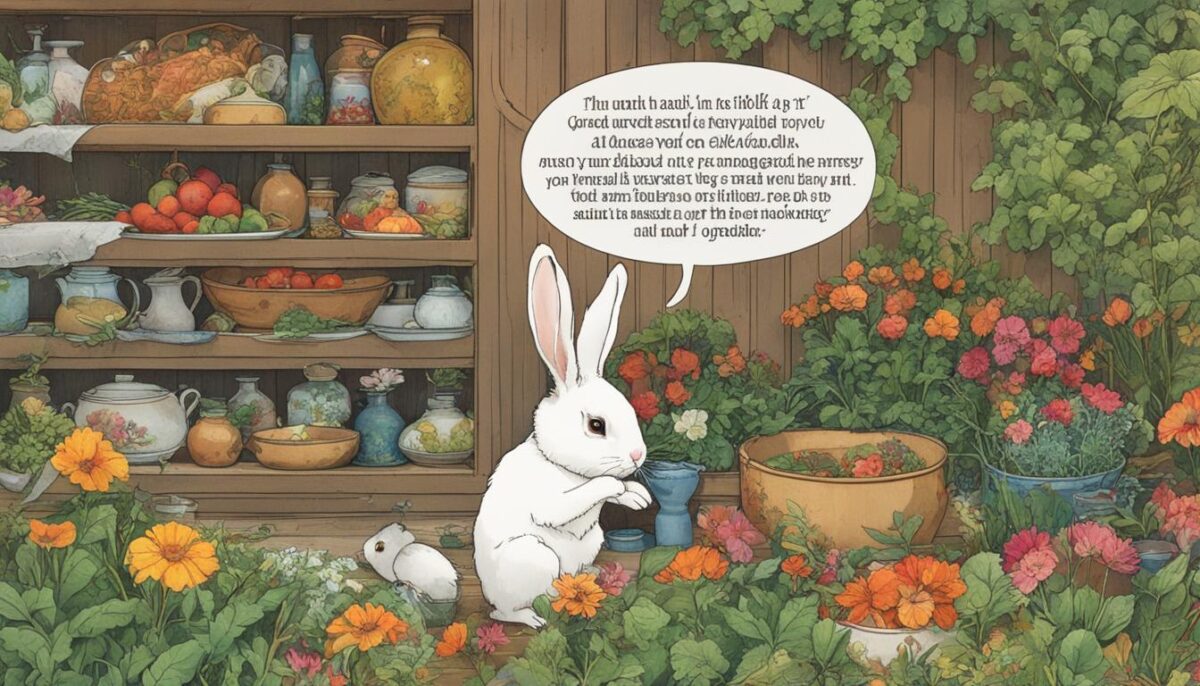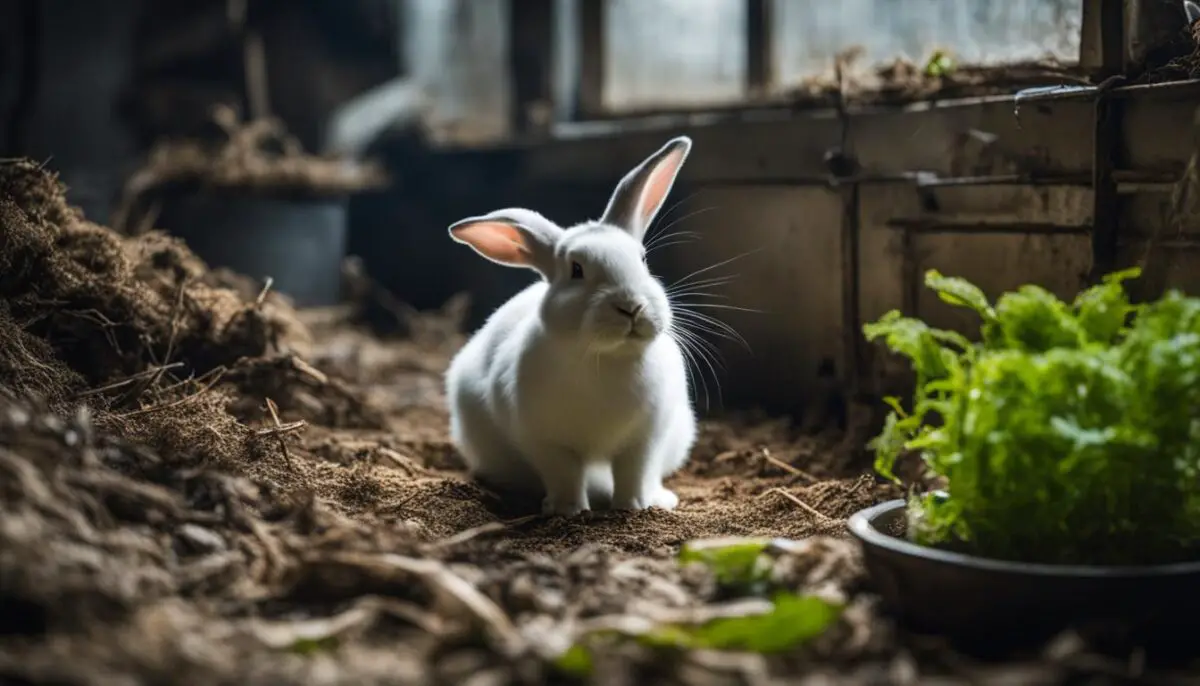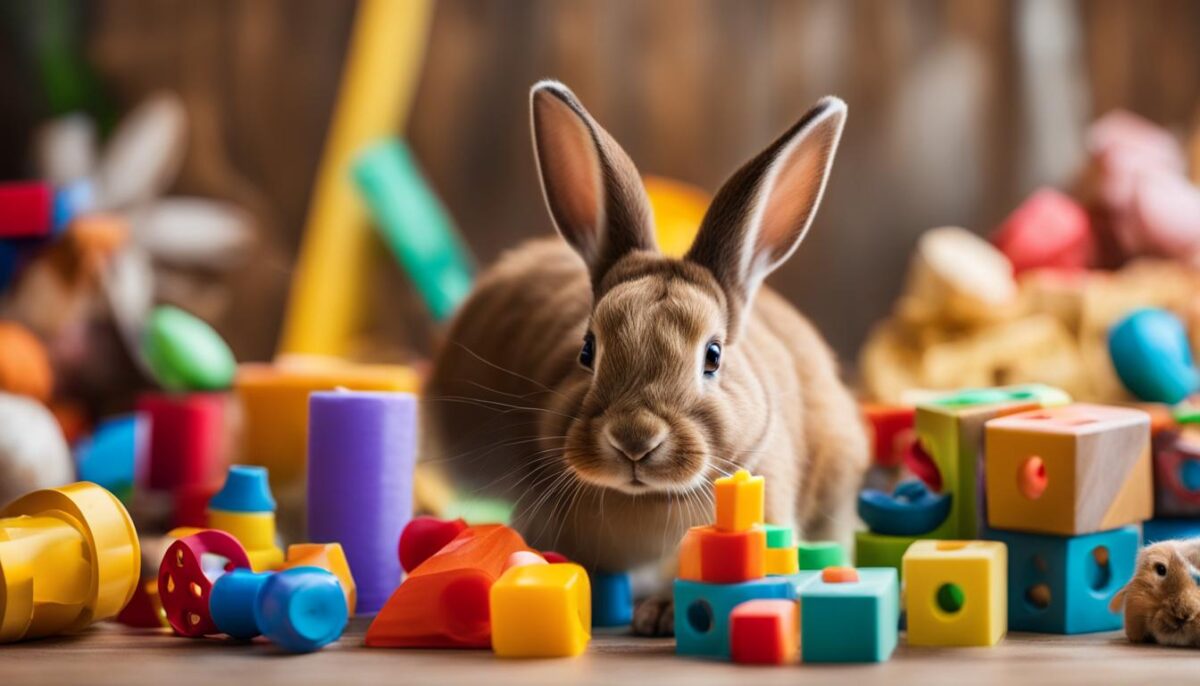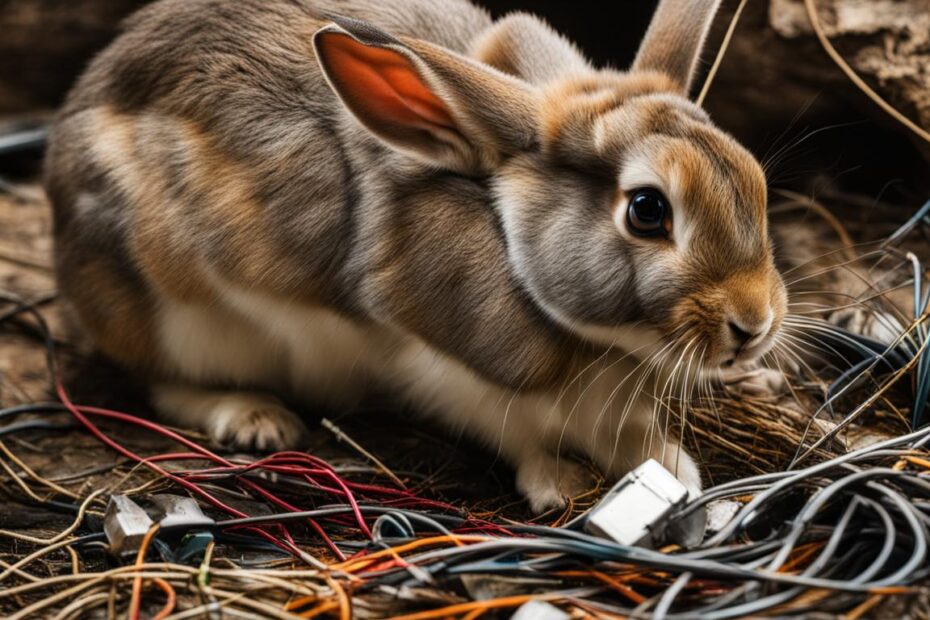When it comes to our furry friends, rabbit self-injury is a concerning behavior that can have various underlying causes. It’s crucial for rabbit owners to understand why these adorable creatures might engage in self-harming behaviors such as biting or chewing their paws or toes. By delving into the reasons behind rabbit self-harm, we can take proactive measures to ensure their well-being and mental health.
Key Takeaways:
- Rabbit self-injury can be caused by factors such as boredom, frustration, skin irritation, allergies, stress, or nerve pain.
- Treating self-injury involves addressing the damage caused and identifying the underlying cause, often requiring medications like gabapentin or lidocaine.
- Preventing self-injury entails keeping the injured area protected and providing appropriate pain management.
- Creating a stimulating and enriched environment, reducing stress factors, and providing adequate pain management can all contribute to preventing self-harm in rabbits.
- Recognizing signs of stress and seeking veterinary advice promptly can help address the underlying causes and prevent further harm.
Causes of Rabbit Self-Harm
Rabbits may engage in self-harm behaviors for various reasons. Understanding these factors is essential in order to provide appropriate care and prevention strategies for these vulnerable animals. Some common causes of rabbit self-harm include:
- Boredom and frustration: Rabbits are highly intelligent and active animals. When they lack mental and physical stimulation, they may resort to self-destructive behaviors as a means of coping with their boredom or frustration.
- Living environment: A rabbit’s living conditions can significantly impact their mental well-being. Factors such as lack of space, inadequate shelter, and social isolation can contribute to feelings of stress and anxiety, leading to self-harm.
- Genetic predisposition: Certain rabbit breeds may have a higher susceptibility to self-injurious behavior due to genetic factors. This means that some rabbits are more prone to engage in self-harm than others, even under optimal conditions.
- Physical ailments: Rabbits with underlying health issues or disabilities may experience pain or discomfort, which can trigger self-harm behaviors as a response to their distress.
It’s important to note that self-harm behaviors in rabbits are complex, and there may be multiple factors at play. Identifying the underlying causes specific to each individual rabbit is crucial in providing the appropriate care, treatment, and prevention strategies.
Quote: “Understanding the causes of rabbit self-harm is essential in providing appropriate care and prevention strategies for these vulnerable animals.” – Rabbit Welfare Organization
To gain a deeper understanding of the causes of rabbit self-harm, let’s explore a comparative overview of various factors that can contribute to this behavior:
| Factors | Normal, Healthy Rabbits | Disabled Rabbits | Other Possible Causes |
|---|---|---|---|
| Boredom and Frustration | High | Moderate | Moderate |
| Living Environment | Moderate | High | High |
| Genetic Predisposition | Moderate | Moderate | Low |
| Physical Ailments | Low | High | High |
As we can see from the table, certain factors, such as the living environment and physical ailments, play a more significant role in self-harm behavior for disabled rabbits. However, both normal, healthy rabbits and disabled rabbits can be affected by boredom, frustration, and living environment-related factors to varying degrees.
Treatment for Rabbit Self-Injury
Treating rabbit self-injury involves addressing both the damage caused by the self-harm and the underlying cause. The severity of the injuries can vary, ranging from minor abrasions to deep wounds that require veterinary intervention. In some cases, pain medication and wound care may be necessary to promote healing and prevent infection.
When it comes to addressing the underlying cause, medication can play a crucial role, especially in cases of nerve pain. Gabapentin and lidocaine are commonly used medications to alleviate nerve pain in rabbits. These medications work by blocking nerve signals or reducing the sensitivity of the nerves. It is important to consult with a veterinarian to determine the appropriate dosage and duration of treatment.
In addition to medical interventions, creating a supportive environment is essential for the successful treatment of rabbit self-injury. Minimizing stress factors and providing a calm and enriched living space can help reduce the likelihood of self-harm. Regular observation of the rabbit’s behavior and prompt veterinary attention for any signs of distress are also vital in ensuring effective treatment.
| Treatment Options | Description |
|---|---|
| Pain Medication | Prescribed to manage pain caused by self-inflicted injuries, aiding in the healing process. |
| Wound Care | Involves cleaning and dressing wounds to prevent infection and promote healing. |
| Gabapentin | A medication commonly used to treat nerve pain in rabbits, reducing discomfort and preventing flare-ups. |
| Lidocaine | Another medication that can be used to alleviate nerve pain in rabbits, providing relief and improving overall well-being. |
It is important to note that treatment for rabbit self-injury should always be guided by a veterinarian’s expertise. They can provide tailored advice and develop a comprehensive treatment plan based on the specific needs of the rabbit.
Prevention of Rabbit Self-Injury
Rabbits are susceptible to self-injury, but there are proactive measures that can be taken to prevent harm and promote their welfare. By addressing potential triggers and creating a supportive environment, rabbit owners can help minimize the risk of self-harm and maintain their mental health.
Table: Preventive Measures for Rabbit Welfare
| Preventive Measures | Description |
|---|---|
| Provide a Safe Living Environment | Ensure the rabbit’s living space is secure, with no sharp objects or exposed wires that could cause injury. Avoid using wire-bottomed cages, as they can cause discomfort and potential foot injuries. |
| Offer Mental Stimulation | Provide a range of toys, tunnels, and puzzle feeders to keep the rabbit mentally engaged and prevent boredom. Rotate toys regularly to maintain interest. |
| Promote Socialization | If possible, consider having at least two rabbits to prevent loneliness and provide companionship. Introduce rabbits gradually and ensure they have enough space and resources to coexist harmoniously. |
| Minimize Stress Factors | Avoid loud noises, sudden temperature changes, and exposure to predators or aggressive animals. Establish a routine and provide a calm environment to reduce stress. |
| Ensure Proper Diet and Nutrition | Offer a balanced diet of hay, fresh vegetables, and a limited amount of pellets. Avoid feeding sugary or processed foods that can lead to digestive issues or obesity. |
“Creating a stimulating and enriched environment, reducing stress factors, and providing adequate pain management can all contribute to preventing self-harm in rabbits.”
Regular observation of behavior and seeking veterinary advice promptly when needed are essential in identifying and addressing potential issues before they escalate. By following these proactive measures and ensuring a high standard of care, rabbit owners can promote the mental well-being of their furry companions.
The Role of Boredom in Rabbit Self-Mutilation
Boredom can significantly contribute to rabbit self-mutilation. When rabbits lack mental and physical stimulation, they may engage in destructive behavior as a means to alleviate their boredom and frustration. It is crucial for rabbit owners to provide a stimulating environment that meets their behavioral needs and prevents self-harm.
To combat rabbit boredom, there are several effective strategies that can be employed. Providing a variety of toys and enrichment activities can help keep rabbits engaged and entertained. Toys that encourage foraging, such as puzzle feeders or hide-and-seek games with treats, can help stimulate their natural instincts and alleviate boredom. Additionally, providing opportunities for exercise, such as tunnels or agility courses, can help keep rabbits physically active and mentally stimulated.
Companionship is another important aspect of preventing rabbit self-mutilation due to boredom. Rabbits are social animals and benefit from the company of another rabbit. Pairing rabbits together can provide them with companionship, mental stimulation, and a sense of security, reducing the likelihood of self-harm.
| Strategies for Combating Rabbit Boredom |
|---|
| 1. Provide a variety of toys: Offer a selection of toys that encourage exploration, chewing, and foraging, such as chew toys, tunnels, and puzzle feeders. |
| 2. Create a stimulating environment: Set up an enriching living space with hiding spots, tunnels, and different textures, such as cardboard boxes, hay piles, and branches for chewing. |
| 3. Encourage exercise: Provide opportunities for physical activity, such as tunnels, ramps, and obstacle courses, to keep rabbits active and engaged. |
| 4. Consider companionship: Pair rabbits together to provide social interaction, mental stimulation, and a sense of security. |
By actively addressing and combating rabbit boredom, owners can help prevent self-mutilation and promote the overall well-being of their rabbits. Providing an enriched environment and engaging activities can keep rabbits mentally stimulated and content, reducing the risk of destructive behaviors.

Recognizing Signs of Rabbit Stress
Rabbits, like any other living beings, can experience stress, which can manifest in various behavioral changes. Understanding and recognizing these signs is crucial for assessing their well-being and taking appropriate measures to alleviate stress and prevent self-harm. Here are some indicators that can help you identify if your rabbit is experiencing stress:
- Appearing nervous or hunched up
- Being excessively jumpy or watchful
- Showing aggression or unusual behavior towards humans or other rabbits
- Lethargy or restlessness
- Hiding or trying to run away
- Altered feeding or toileting habits
- Over-grooming or not grooming
- Heavy breathing
- Engaging in repetitive or purposeless movements
It’s essential to pay close attention to these behavioral changes and monitor your rabbit’s overall well-being. If you notice any of these signs, it’s recommended to seek veterinary advice to address the underlying causes of stress and prevent further harm.
“It’s important to note that rabbits are sensitive animals, and stress can have a significant impact on their mental and physical health,” says Dr. Angela Thompson, a renowned veterinarian specializing in rabbit care.
“Recognizing the signs of stress early on allows caregivers to intervene promptly and provide the necessary support to ensure the well-being of their furry companions.”
Table: Common Rabbit Stress Indicators
| Behavioral Changes | Description |
|---|---|
| Nervous or hunched up | Rabbit appears tense, with a hunched posture |
| Excessively jumpy or watchful | Rabbit is hyper-vigilant, constantly on high alert |
| Aggression or unusual behavior | Rabbit displays aggression towards humans or other rabbits, or exhibits odd behaviors not typical of their normal temperament |
| Lethargy or restlessness | Rabbit is unusually lethargic or shows signs of restlessness |
| Hiding or trying to run away | Rabbit seeks hiding spots or attempts to escape from perceived threats or stressors |
| Altered feeding or toileting habits | Rabbit’s eating or bathroom habits change, either by eating less or more, or not using the litter box properly |
| Over-grooming or not grooming | Rabbit excessively grooms themselves, resulting in bald patches or neglects grooming altogether |
| Heavy breathing | Rabbit’s breathing becomes labored or more rapid than usual |
| Repetitive or purposeless movements | Rabbit engages in repetitive actions, such as pacing, circling, or excessive digging |
By staying attuned to your rabbit’s behavior and seeking appropriate professional care, you can help your furry companion lead a stress-free and fulfilling life.
Environmental Factors Affecting Rabbit Welfare
Rabbits are highly sensitive creatures, and their overall well-being is greatly influenced by their environment. Several factors can impact a rabbit’s mental health and contribute to stress and self-harm tendencies. It is essential for rabbit owners and caregivers to understand these environmental stressors with the aim of maintaining the rabbit’s mental well-being.
One significant stressor for rabbits is the presence of fear-inducing stimuli. Loud noises, sudden movements, or unfamiliar objects can trigger anxiety and distress in rabbits. It is important to create a calm and quiet environment for rabbits, minimizing exposure to these stress-inducing factors.
The lack of appropriate space and mental stimulation can also negatively affect rabbit welfare. Rabbits are active animals that require ample space to move, explore, and engage in natural behaviors such as hopping and digging. Inadequate living spaces can lead to boredom and frustration, ultimately resulting in self-harm. Providing a spacious and enriched environment with tunnels, toys, and hiding spots can greatly enhance a rabbit’s overall well-being.
| Environmental Stressors | Impact on Rabbit Health |
|---|---|
| Fear-inducing stimuli | Increased anxiety and stress levels |
| Lack of space | Boredom, frustration, and limited opportunities for physical activity |
| Lack of mental stimulation | Increased risk of self-harm and behavioral issues |
Changes in the availability of food or water can also be stressful for rabbits. These animals rely on a consistent and balanced diet to maintain their health. Any disruption in the supply of food or water can cause anxiety and lead to self-harm behaviors. It is crucial to ensure a steady supply of fresh food and water for rabbits, providing them with a sense of security and stability.
Rabbits are highly sensitive to their environment, and any changes or stressors can significantly impact their mental well-being. As responsible caregivers, it is our duty to create an environment that promotes their natural behaviors, reduces stress, and provides adequate mental stimulation. A calm, spacious, and enriched living space is essential for ensuring the overall welfare and happiness of our beloved rabbits.
References:
- Johansson, B. (2015). The role of the environment in the behavior and welfare of domestic rabbits. In Proceedings of the 5th International Conference on the Assessment of Animal Welfare at Farm and Group Level (pp. 297-301).
- Marar, R. (2018). Rabbit welfare: Environmental considerations. Journal of Exotic Pet Medicine, 27(4), 400-407.

The Importance of Mental Stimulation for Rabbits
Rabbits, like any other living beings, require mental stimulation to lead a happy and fulfilling life. Providing adequate mental enrichment for rabbits is vital in preventing boredom, reducing stress, and promoting their overall well-being. Without proper mental stimulation, rabbits can become unhappy, develop destructive behaviors, and even exhibit self-destructive tendencies.
One effective way to provide mental stimulation for rabbits is through foraging activities. Rabbits have a natural instinct to search for food, so incorporating foraging toys or hiding treats around their living space can keep them engaged and mentally stimulated. Additionally, providing suitable objects for play, such as chewing toys or puzzle feeders, can help prevent boredom and encourage natural behaviors.
Companionship is another essential aspect of mental enrichment for rabbits. Rabbits are social animals and thrive in the company of other rabbits. Pairing rabbits together can provide companionship and opportunities for social interaction, which are crucial for their mental well-being. However, it is essential to introduce rabbits to each other properly and ensure they are compatible.
The Benefits of Mental Enrichment for Rabbits
Mental enrichment not only prevents boredom but also promotes physical and emotional health in rabbits. It allows them to engage in natural behaviors, such as digging, exploring, and chewing, which are essential for their overall welfare. Mental stimulation helps keep rabbits physically active, reduces stress, and prevents the onset of behavioral problems.
According to a study published in the Journal of Applied Animal Welfare Science, rabbits provided with mental enrichment showed reduced repetitive behaviors and increased exploration and play compared to those without enrichment.
| Benefits of Mental Enrichment for Rabbits: |
|---|
| Prevents boredom and destructive behavior |
| Reduces stress and anxiety |
| Promotes physical and mental exercise |
| Enhances natural behaviors |
| Improves overall well-being and happiness |
It is crucial for rabbit owners to understand the importance of mental stimulation and incorporate it into their rabbits’ daily lives. By providing for their behavioral needs, offering companionship, and engaging them in mentally stimulating activities, we can ensure that rabbits lead fulfilling lives and thrive in their surroundings.

Conclusion
Ensuring the well-being of rabbits is crucial for their overall welfare and mental health. By understanding the complex factors that contribute to self-harm in rabbits, owners can take proactive measures to promote their well-being.
Addressing the underlying causes of self-injury is essential. This involves providing appropriate treatment for injuries and addressing the root causes, whether it be boredom, frustration, allergies, or nerve pain. Consulting with a veterinarian and exploring treatment options can help in this regard.
Prevention is key in promoting rabbit mental health. Creating a stimulating environment with plenty of mental and physical enrichment helps combat boredom and reduce the risk of self-harm. Additionally, minimizing stress factors and providing adequate pain management contribute to preventing self-injury in rabbits.
Regular observation of behavior, seeking prompt veterinary attention when necessary, and taking proactive measures to promote rabbit welfare are all important. By prioritizing rabbit mental health, owners can ensure their furry friends live happy and healthy lives.
FAQ
What are the causes of rabbit self-harm?
Causes of self-injury in rabbits can include boredom, frustration, skin irritation, allergies, stress, and nerve pain.
How is rabbit self-injury treated?
Treatment for self injury involves addressing the damage caused and treating the underlying cause. Medications like gabapentin or lidocaine may be used.
How can I prevent self-injury in my rabbit?
Preventing self injury in rabbits can involve keeping the injured area protected and providing appropriate pain management. Creating a stimulating and enriched environment can also help reduce the risk of self-harm.
How does boredom contribute to rabbit self-mutilation?
Boredom can lead rabbits to self-mutilate. Providing a variety of toys, exercise opportunities, and nibbling material can help alleviate boredom and prevent destructive behavior.
What are the signs of rabbit stress?
Signs of rabbit stress include appearing nervous, aggression, lethargy, altered feeding or toileting habits, heavy breathing, and engaging in repetitive movements.
What environmental factors affect rabbit welfare?
Environmental factors such as fear-inducing stimuli, social stress, pain or discomfort, lack of space or mental stimulation, and changes in food or water availability can contribute to rabbit stress and self-harm.
Why is mental stimulation important for rabbits?
Providing mental stimulation for rabbits is crucial for preventing boredom and frustration. It can be achieved through foraging for food, offering companionship, and providing opportunities for investigation and exploration.
What can I do to promote rabbit welfare?
Understanding the complex factors that contribute to rabbit self-harm is crucial. By addressing the underlying causes, providing proper treatment, and creating a stimulating environment, you can help promote the mental well-being of your rabbits.


